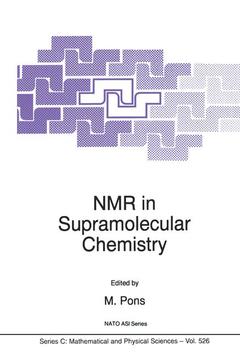Description
NMR in Supramolecular Chemistry, Softcover reprint of the original 1st ed. 1999
Nato Science Series C: Series, Vol. 526
Coordinator: Pons M.
Language: English
Subjects for NMR in Supramolecular Chemistry:
Publication date: 10-2012
337 p. · 16x24 cm · Paperback
337 p. · 16x24 cm · Paperback
Description
/li>Contents
/li>
NMR is better suited than any other experimental technique for the characterization of supramolecular systems in solution. The presentations included here can be broadly divided into three classes. The first class illustrates the state of the art in the design of supramolecular systems and includes examples of different classes of supramolecular complexes: catenanes, rotaxanes, hydrogen-bonded rosettes, tubes, capsules, dendrimers, and metal-containing hosts. The second class comprises contributions to NMR methods that can be applied to address the main structural problems that arise in supramolecular chemistry. The third class includes biological supramolecular systems studied by state-of-the-art NMR techniques.
Probing Self-Assembly by NMR.- Study of Conformational Behavior of CMP(O)-Cavitands by NMR Spectroscopy and X-Ray Analysis in Relation to the Extraction Properties.- NMR Studies of Molecular Recognition by Metalloporphyrins.- Reversible Dimerization of Tetraureas Derived from Calix[4]arenes.- Self-Assembling Peptide Nanotubes.- Symmetry: Friend or Foe?.- Quenching Spin Diffusion in Transferred Overhauser Studies and Detection of Octupolar Order in Gaseous Xenon-131.- Applications of NMR Spectroscopy to the Study of the Bound Conformation of O- and C-Glycosides to Lectins and Enzymes.- Application of NMR to Conformational Studies of an HIV Peptide Bound to a Neutralizing Antibody.- Paramagnetic NMR Effects of Lanthanide Ions as Structural Reporters of Supramolecular Complexes.- Characterization of Reaction Complex Structures of ATP-Utilizing Enzymes by High Resolution NMR.- Spin Relaxation Methods for Characterizing Picosecond-Nanosecond and Microsecond-Millisecond Motions in Proteins.- Structural Diversity of the Osmoregulated Periplasmic Glucans of Gram-Negative Bacteria by a Combined Genetics and Nuclear Magnetic Resonance Approach.- NMR Studies of the 269 Residue Serine Protease PB92 from Bacillus Alcalophilus.- Intermolecular Interactions of Proteins Involved in the Control of Gene Expression.- NMR-Based Modeling of Protein-Protein Complexes and Interaction of Peptides and Proteins with Anisotropic Solvents.- Protein Surface Recognition.- NMR Studies of Protein-Ligand and Protein-Protein Interactions Involving Proteins of Therapeutic Interest.- NMR Diffusion Measurements in Chemical and Biological Supramolecular Systems.- Determination of Calixarene Conformations by Means of NMR Techniques.- Structure, Molecular Dynamics, and Host-Guest Interactions of a Water-Soluble Calix[4]arene.- Cation Complexation and Stereochemistry of Macrocycles Studied by 13C NMR Relaxation-Time Measurements.- A Comparative Study on Liquid State CSA Methods.- Hydrogen Bonding and Cooperativity Effects on the Assembly of Carbohydrates.- Influence of Substituents on the Edge-to-Face Aromatic Interaction: Halogens.
© 2024 LAVOISIER S.A.S.




